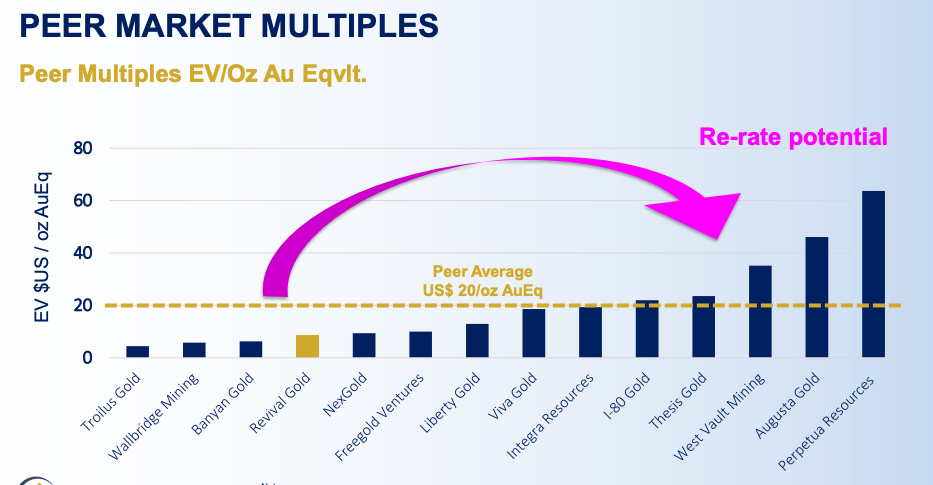Gold's Resurgence: Why Investors Should Consider the Yellow Metal

Gold reaches record highs amid market volatility; Revival Gold leverages brownfield U.S. projects with 6M oz resource and strong economics at $3,000 gold.
- Revival Gold's Mercur Gold Project PEA demonstrates robust economics with 95,600 ounces of gold production annually over a 10-year mine life
- The company's stock has risen 30% following the PEA announcement, yet remains below analyst targets of C$1.25/share
- Gold has reached all-time highs of approximately $3,250 per ounce amid market volatility and declining U.S. Treasury bond values
- Revival Gold controls approximately 6 million ounces of gold resources across two U.S. projects with potential production of 160,000 ounces annually
- At $3,000 gold, Revival Gold's NAV increases 2.5x to $1.2 billion, demonstrating significant leverage to higher gold prices
Gold Reaches New Heights in Turbulent Markets
Gold has experienced a dramatic resurgence in recent months, reaching unprecedented price levels and confirming its status as a premier store of value during uncertain economic times. Currently trading at all-time highs of approximately $3,250 per ounce, gold has demonstrated remarkable resilience and upward momentum despite initial hesitations following the implementation of wide-ranging tariffs by the United States. This significant price appreciation signals what market participants are increasingly describing as a paradigm shift in gold's position within global investment portfolios.
The catalysts behind this remarkable performance extend beyond normal market fluctuations. Recent weeks have witnessed extreme market volatility across various asset classes, with traditional safe havens like U.S. treasury bonds experiencing unusual selling pressure. The 10-Year Treasury yield reached 4.5%, effectively putting these instruments "on sale," while simultaneously the U.S. dollar index declined to six-month lows. According to analysis from RBC Capital Markets, this uncommon market behavior may be attributed to the flight of foreign capital from U.S. investments due to an increasingly unpredictable economic and political environment, as well as the unwinding of the "basis trade" that had previously suppressed gold prices.
These macroeconomic factors have converged to create an environment where gold's 5,000-year track record as mankind's premier store of value has become increasingly relevant to a diverse range of investors. Central banks, sovereign wealth funds, insurance companies, high-net-worth individuals, family offices, and retail investors are all reassessing gold's role in their investment strategies amid heightened economic uncertainty.
Gold's Historical Performance During Economic Uncertainty
Gold has historically performed well during periods of economic instability, serving as an effective hedge against both inflation and currency devaluation. The current market conditions exemplify precisely the type of environment where gold typically excels. With the U.S. dollar weakening and traditional fixed-income investments facing challenges, gold has emerged as a beneficiary of capital flows seeking stability.
The metal's intrinsic properties – limited supply, universal recognition, and no counterparty risk – make it particularly attractive when confidence in financial systems or currencies wavers. Unlike fiat currencies, which can be devalued through monetary policy decisions, gold maintains its purchasing power over extended timeframes. This characteristic becomes especially valuable during periods of economic uncertainty, currency fluctuations, or geopolitical tensions.
The current gold price trajectory reflects growing concerns about long-term inflation, currency stability, and geopolitical risks. As central banks continue to hold substantial interest rates following years of quantitative easing, investors are increasingly seeking alternatives to traditional financial assets that may be vulnerable to these policies' long-term consequences.
Mining Equities: Leveraged Exposure to Gold
While physical gold offers direct exposure to price movements in the metal itself, gold mining equities present investors with potentially greater returns through operational leverage. Mining companies, particularly developers and producers, typically experience amplified stock price movements relative to changes in the underlying gold price. This leverage effect can significantly enhance returns during gold bull markets.
Gold development companies, which focus on advancing projects toward production, often exhibit the most substantial leverage to rising gold prices. As project economics improve dramatically with higher gold prices, the net present value (NPV) of these companies can increase at multiples of the percentage change in gold prices. This dynamic creates opportunities for investors seeking maximized exposure to gold price appreciation.
For example, when evaluating gold development projects, a move in the gold price from $2,175 to $3,000 per ounce (a 38% increase) might translate to a 150% increase in a project's after-tax NPV. This leveraged effect explains why carefully selected gold mining equities can outperform the metal itself during strong bull markets for gold.
US Gold Projects: Strategic Advantage in a Changing World
Gold projects located in stable mining jurisdictions like the United States offer additional strategic advantages for investors. As global supply chains face increasing scrutiny and nations prioritize domestic resource security, gold assets in politically stable regions with established mining frameworks become increasingly valuable.
The western United States has historically been a significant gold-producing region with well-established infrastructure, skilled labor pools, and supportive regulatory environments in many areas. These factors contribute to reduced development risk and potentially accelerated timelines for bringing new projects into production—critical advantages in capturing value from higher gold prices.
Mining projects in the U.S. also benefit from proximity to sophisticated financial markets, technical expertise, and established refining and transportation infrastructure. These elements create operational efficiencies that can enhance project economics and reduce execution risk compared to more remote or politically unstable jurisdictions.
As global tensions rise and countries increasingly focus on securing critical mineral supplies domestically, gold projects in the United States represent not only economic opportunities but also strategic investments aligned with broader macroeconomic and geopolitical trends.
The Investment Thesis for Revival Gold
- Dual-Project Portfolio: Controls two significant gold projects in the Western U.S. (Beartrack-Arnett in Idaho and Mercur in Utah) with combined resources of approximately 6 million ounces, offering investors exposure to multiple development opportunities
- Significant Production Potential: Plans target combined production of 160,000 ounces annually from both projects, positioning the company as a meaningful mid-tier producer
- Compelling Project Economics: Mercur PEA demonstrates after-tax NPV5% of $294 million at $2,175/oz gold, increasing to $752 million at $3,000/oz gold, showing exceptional leverage to higher gold prices
- Experienced Management Team: Led by industry veterans with track records at major mining companies including Kinross Gold, Barrick, and Deutsche Bank Global Metals & Mining
- Strong Institutional Support: 48% institutional and corporate ownership demonstrates confidence from sophisticated investors
- Favorable Mining Jurisdictions: Projects located in Idaho and Utah, ranked among the top 20 mining jurisdictions globally according to the Fraser Institute's 2023 Survey
- Brownfield Advantage: Both projects are brownfield sites with previous production and existing infrastructure, reducing development risk and potentially accelerating timelines
- Attractive Valuation: Currently trading at approximately 0.10x P/NAV and $8/oz, representing a significant discount to peer averages of 0.4x P/NAV and $20/oz
- Active Exploration Potential: Multiple high-priority exploration targets could extend mine life and enhance project economics
- Action Plan for Investors: Consider establishing a position at current levels with potential to add during project advancement milestones; monitor gold price movements, permitting progress, and exploration results as key catalysts

Conclusion: Gold's Renewed Promise
The convergence of macroeconomic uncertainty, declining confidence in traditional financial assets, and increased global tensions has created a compelling environment for gold investments. As the metal continues to demonstrate its enduring value as a store of wealth, investors have multiple options for gaining exposure – from physical gold to mining equities with operational leverage to price movements.
Gold development companies in stable jurisdictions like the United States offer particularly attractive opportunities, with the potential for outsized returns as project economics improve dramatically with rising gold prices. For investors seeking to capitalize on gold's resurgence while maximizing return potential, carefully selected mining equities represent a strategic allocation in today's uncertain economic landscape.
The Gold Macro Thematic: A Fundamental Shift
The current gold market represents more than a cyclical upturn – it signals a fundamental reassessment of gold's role in the global financial system. Several powerful forces are converging to drive this transformation: unprecedented levels of sovereign debt, persistent inflation concerns despite aggressive interest rate policies, geopolitical fragmentation, and waning confidence in traditional reserve currencies including the U.S. dollar.
Central banks have emerged as significant net buyers of gold, with purchases reaching record levels in recent years. This institutional accumulation reflects strategic diversification away from dollar-denominated assets and recognition of gold's enduring value in times of systemic stress. The trend extends beyond traditional gold-holding nations to include emerging economies seeking to reduce dependence on the Western financial system.
Technological innovation is also supporting gold's resurgence, with blockchain-based gold products making ownership more accessible and transparent for retail investors. Meanwhile, environmental pressures on cryptocurrencies have highlighted gold's relatively lower total environmental impact when evaluated across its full life cycle.
Perhaps most significantly, the demographic shifts underway in developed economies – aging populations with increasing risk aversion and wealth preservation priorities – naturally favor gold allocation. As the largest intergenerational wealth transfer in history unfolds over the next decade, gold stands to benefit as conservative investment preferences gain prominence.
"We've seen fundamental shifts in market dynamics before, but what's happening with gold now represents a convergence of macroeconomic, geopolitical, and demographic factors that could sustain a multi-year revaluation of gold's role in the global financial system. The flight of foreign capital from U.S. investments, declining dollar strength, and the unwind of trading strategies that previously suppressed gold prices have created what appears to be a paradigm shift in how investors value this 5,000-year-old store of value." – Hugh Agro, President & CEO of Revival Gold
Analyst's Notes




Subscribe to Our Channel
Stay Informed



































